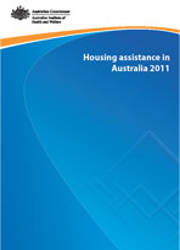Summary
Housing plays an important role in the health and wellbeing of Australians and, in doing so, promotes positive health, education, employment and security for individuals (FaCSIA 2007).
Population growth and the reduction in the average household size have led to an increased demand for housing (AIHW 2009a). This increased demand has not been met by a similar increase in the supply of housing. As a result, almost 497,000 low-income households are spending more than 30% of their income on housing costs, and are classified as being ‘in housing stress’. With 45% of low-income private renters and 42% of low-income mortgagees in housing stress, housing assistance is increasingly an essential ‘safety net’ for Australians in need.
The National Affordable Housing Agreement is a commitment by all governments in Australia to deliver housing assistance, with the broad aim of ensuring that all Australians have ‘access to affordable, safe and sustainable housing that contributes to social and economic participation’. This report provides information on the main housing assistance programs in Australia covered by the agreement, including social housing programs, and private rental market and home purchase assistance.
In June 2010:
- 337,177 households were in public rental housing, and state owned and managed Indigenous housing (SOMIH)
- 42,414 households were in mainstream community housing (CH)
- 19,096 dwellings were managed and/or owned by Indigenous community housing organisations
- 34,031 households had been newly assisted by public rental housing, SOMIH and mainstream CH programs during 2009–10
- 154,435 households were supported by private rent assistance programs
- 44,210 households were supported by home purchase assistance programs
- around 1.1 million income units (a single person or couple, with or without dependent children) were receiving Commonwealth Rent Assistance.
While social housing dwelling numbers have increased only slightly (from 406,500 dwellings to 414,600 dwellings) over the 7 years to 2009–10, there has been a gradual but steady shift of focus from the public to the community-managed sector. At 30 June 2010 mainstream CH managed more than 11% of social housing dwellings, up from the 7% of 7 years earlier.
Social housing continues to be rationed to those in the highest category of need, with 75% of allocations in public rental housing, 56% of SOMIH and 63% of mainstream CH provided to people who were homeless, whose life or safety was at risk in their accommodation, whose condition was aggravated by their housing or who had very high rental costs.
Housing assistance is also targeted towards key special needs groups including Indigenous Australians, those with disability, the young and the elderly. In 2009–10, 65% of new households assisted in public rental housing were in one of these groups, with a similarly high proportion in mainstream CH (57%).



